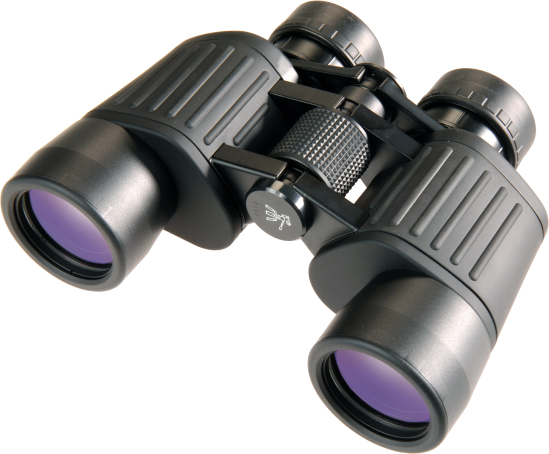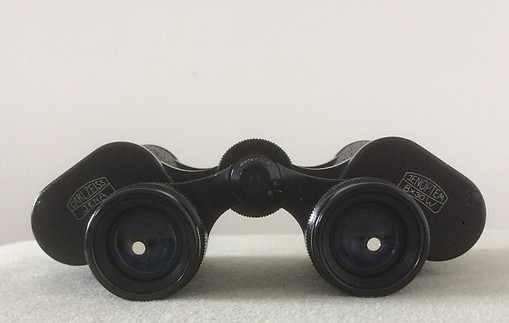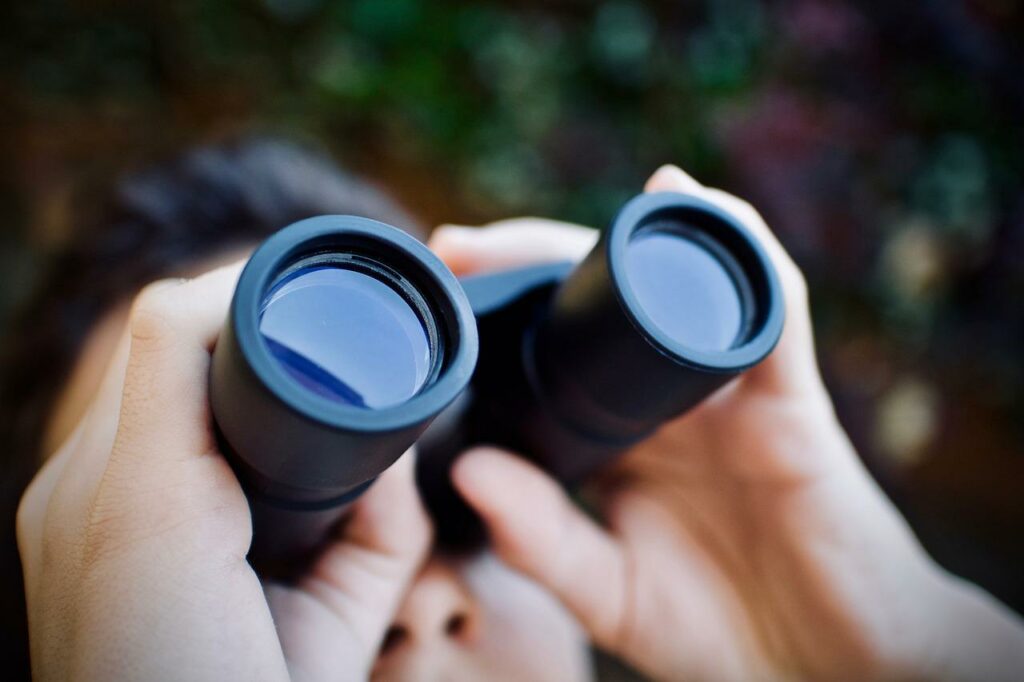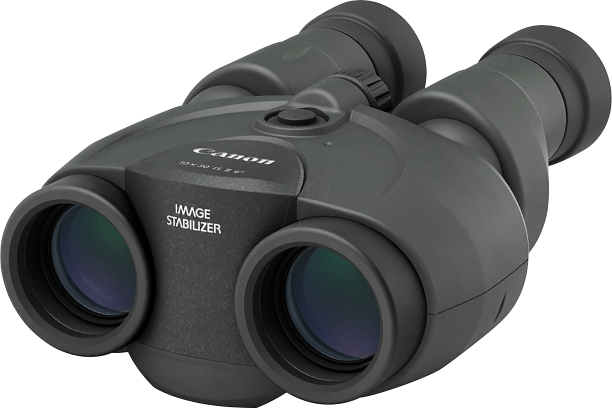Many of us have an old pair of binoculars tucked away in a cupboard somewhere — maybe from a long-forgotten holiday or a birdwatching phase. But did you know those same binoculars can open up the night sky?
Using binoculars for stargazing is one of the easiest and most affordable ways to get started in astronomy. With their wide field of view and no setup fuss, binoculars are perfect for casual observing — and they often spark a lifelong passion for the stars.
Quick Start — Stargazing with Binoculars
- Start with 7×50 or 10×50 binoculars — bright, stable, and beginner friendly.
- Stabilise the view by resting your elbows, using a wall/tree, or a tripod adapter.
- Try easy targets first: the Moon, the Pleiades, and patches of the Milky Way.
- Choose multi-coated lenses for the best low-light performance.
If you’re new to this, don’t worry — this guide will walk you through everything you need to know:
✅ The different binocular styles
✅ What all those numbers mean
✅ How magnification and aperture affect what you see
✅ How to choose the best binoculars for your needs
💡 Quick Tip:
Ready to skip straight to recommendations? Check out my Best Binoculars for Stargazing post — I’ve reviewed some excellent options for every budget.
The Two Main Types of Binoculars
Binoculars are basically two tiny telescopes joined together, each with a lens at the front (the objective lens) and an eyepiece at the back.
What makes them different from a telescope is the use of prisms, which fold the light and make the design much more compact and comfortable.
There are two main types of binoculars, based on the prism design: Porro prism and Roof prism.
Porro Prism Binoculars
Porro prism binoculars are the classic shape most people imagine — the eyepieces are closer together than the objective lenses, creating that familiar zigzag body.
They’re usually more affordable, give great depth perception, and feel comfortable to hold.

Pros:
- Typically cheaper
- Bright, high-contrast image
- Comfortable hand grip
Cons:
- Bulkier and heavier than roof prism models
Roof Prism Binoculars
Roof prism binoculars look sleek and straight — the light path runs in line with the barrel. They’re more compact, lighter, and easier to pack for travel, though that convenience can come at a higher price due to their more complex construction.

Pros:
- Lightweight and portable
- Modern design
- Durable and weather-resistant
Cons:
- Usually more expensive
- Slightly less light transmission (unless high-quality coatings are used)
There are a few things you need to know before you buy. Understanding a few key terms will help you choose binoculars that are truly suited for stargazing.
What Do the Numbers Mean?
Every pair of binoculars has two numbers — for example, 10×50 or 8×30, as shown in the photo below.

- The first number is the magnification (how many times closer objects appear).
- The second number is the aperture, or diameter of the front lens, measured in millimetres.
So, 10×50 binoculars magnify objects ten times and have a 50mm aperture.
⚠️ Skip Zoom Models: Zoom binoculars (e.g., “8–20×40”) sound flexible but are rarely precise enough for astronomy. Stick with fixed magnification for clearer images.
Aperture: Why Size Matters
A larger aperture means more light-gathering power — crucial for night-sky observing. For astronomy, you want lenses at least 42mm or larger. Smaller lenses work fine for daytime use (like birdwatching), but they won’t gather enough starlight after dark.
✅ Good balance for beginners:
10×50 binoculars are a fantastic all-round choice — bright, stable, and powerful enough to reveal clusters and nebulae. See my top 10×50 binocular picks here
Magnification – Finding the Sweet Spot
More magnification isn’t always better. While it lets you see finer detail, it also magnifies any hand shake and narrows your field of view.
- 7x–10x: Ideal for most beginners — wide view, steady image, bright results.
- 12x and higher: More detail but harder to hold steady (often need a tripod).
If you want handheld simplicity, stay around 8x or 10x. You’ll see more stars, and the view will feel smooth and natural.
The “Exit Pupil” Explained
Hold your binoculars up to the light — you’ll see a small bright circle behind each eyepiece. That’s the exit pupil — the column of light entering your eyes.

Binoculars Showing ‘Exit Pupil’
You can calculate its size by dividing the aperture by the magnification.
For example, 7×50 binoculars have an exit pupil of about 7.1mm (50 ÷ 7 = 7.1).
For young eyes that dilate widely in the dark, a 7mm exit pupil makes the most of every photon. Older observers like me (sigh!) might only benefit from 4–5mm, so a 10×50 (5mm exit pupil) can be the better match.
Optical Coatings – The Secret to Sharp Views
Every glass surface reflects some light, which reduces brightness and contrast.
To counter this, binoculars use optical coatings — ultra-thin layers that enhance light transmission.

Types of coatings:
- Coated: One basic layer on some surfaces
- Fully Coated: One layer on all air-to-glass surfaces
- Multi-Coated: Several layers on one or more surfaces
- Fully Multi-Coated: Multiple layers on every surface (the best choice!)
If you’re serious about stargazing, look for fully multi-coated lenses — they deliver brighter, crisper images.
Image-Stabilized Binoculars – The Premium Option
For the ultimate experience, consider image-stabilized binoculars. These use electronic sensors to counteract shaking — perfect for high magnification or when viewing without a tripod.

They’re pricey, but if your budget allows, they’re incredible for astronomy.
Pros and Cons of Stargazing with Binoculars
👍 Advantages
- See up to 50x more stars than with the naked eye
- No setup time — just grab and go
- Wide field of view makes learning constellations easier
- Use both eyes, which feels natural and boosts detail
- Great for dual use (birdwatching, nature, travel)
👎 Disadvantages
- Limited planetary detail (no rings or cloud bands)
- High magnification = more shake and less light
- Large binoculars can be heavy — a tripod mount helps for longer sessions
Choosing Binoculars – Striking a Balance
Binoculars are the perfect “first step” into stargazing — no setup, no alignment, just instant exploration.
If you’re unsure what to pick, here’s a quick guide:
| Type | Example | Best For | Notes |
|---|---|---|---|
| Porro Prism 10×50 | Celestron SkyMaster | Beginners | Bright, affordable, wide view |
| Roof Prism 10×42 | Nikon Monarch M5 | Travellers | Lightweight and durable |
| Image Stabilized 12×36 | Canon IS III | Enthusiasts | Shake-free but pricey |
My Recommendation:
For most beginners, a 10×50 Porro prism pair offers the best mix of brightness, comfort, and value. Check current prices in my Best Binoculars for Stargazing post.
Frequently Asked Questions About Binoculars for Stargazing
1. Can you really use binoculars for stargazing?
Definitely! Binoculars are one of the easiest and most affordable ways to explore the night sky. They show amazing detail — from the Moon’s craters to Jupiter’s bright moons — without the setup time of a telescope. If you’re curious which models perform best, check out our Best Binoculars for Stargazing guide for detailed reviews and recommendations.
2. What binocular size is best for astronomy beginners?
A great starting point is 7×50 or 10×50 binoculars. The first number shows the magnification, while the second is the lens diameter in millimetres — bigger lenses gather more light for brighter, clearer views.
3. How do you use binoculars for astronomy?
For the steadiest view, rest your elbows on a surface or use a tripod adapter (a small accessory that keeps your binoculars still). Start with the Moon to practice focusing, then move to star clusters like the Pleiades or the Milky Way.
4. Can binoculars replace a telescope?
Not completely — telescopes can reveal far more detail on planets and deep-sky objects. But binoculars offer a wide, immersive field of view, making them perfect for scanning constellations and large celestial regions. Many astronomers actually start with binoculars before upgrading to a telescope.
5. Do I need special binoculars for stargazing?
You don’t need professional gear to enjoy the stars, but binoculars made for low-light viewing (like marine or astronomy models) will give you the brightest images. Look for multi-coated lenses and a sturdy, comfortable grip.
Final Thoughts
Binoculars are a fantastic way to begin your journey into astronomy. They’re affordable, portable, and surprisingly powerful — letting you see craters on the Moon, the moons of Jupiter, and countless star clusters and nebulae.
Once you’ve fallen in love with exploring the night sky, you might eventually want to upgrade. When that time comes, don’t miss my How to Buy a Telescope guide — it’s the next step up from binocular astronomy.
Until then, grab your binoculars, step outside, and enjoy the cosmos!
